Connect Memory and Signadot to Build Intelligent Automations
Choose a Trigger
When this happens...
- Request a new Trigger for Memory
Choose an Action
Automatically do this!
Search clusters
Delete Cluster
Create Cluster
Delete a resource plugin
Delete Routegroup
Search Routegroups
Use the Built-in Integrations
Actions and Triggers
When this happensTriggers
A trigger is an event that starts a workflow.
Cluster created
Trigger when new Cluster created.
Cluster token created
Trigger when new token created to a selected cluster.
Resource Plugins Created
Trigger when new resource plugins created.
Route Groups Created
Trigger when new routegroups created.
Route Group Updated
Trigger when new routegroups Updated.
Do thisActions
Action is the task that follows automatically within your Memory integrations.
Add new record
Store new data seamlessly within your workflow using the Create action. Whether you're saving configurations, flags, or other crucial information, this action securely adds data to your MongoDB-based storage, ready for use in your automation flow.
Find record
Effortlessly access stored data with the Read action. Retrieve any saved information at any point in your flow to support decision-making and trigger subsequent actions based on the retrieved data.
Update a record
Modify specific records using the Update by ID action. This allows you to directly update a particular entry in your MongoDB storage by its unique identifier, ensuring precise changes to your stored data.
Update record using filter
Refine and update multiple records at once with the Update by Filter action. Use filters to target specific criteria, making bulk updates to all matching entries within your storage, enhancing efficiency and control in your workflow.
Delete record by Id
Maintain an organized and efficient workflow by removing unnecessary data with the Delete action. This allows you to securely delete obsolete records, optimizing your storage for active and relevant information.
Create or update record
Know More About Memory and Signadot Integrations

How viaSocket Works | A Complete Guide
Gain insights into how viaSocket functions through our detailed guide. Understand its key features and benefits to maximize your experience and efficiency.

5 Simple Automation Hacks to Make Your Team Free
Unlock your team's potential with 5 straightforward automation hacks designed to streamline processes and free up valuable time for more important work.

What is Workflow Automation - Definition, Importance & Benefits | A Complete Guide
Workflow automation is the process of using technology to execute repetitive tasks with minimal human intervention, creating a seamless flow of activities.
Frequently Asked Questions
To start, connect both your Memory and Signadot accounts to viaSocket. Once connected, you can set up a workflow where an event in Memory triggers actions in Signadot (or vice versa).
Absolutely. You can customize how Memory data is recorded in Signadot. This includes choosing which data fields go into which fields of Signadot, setting up custom formats, and filtering out unwanted information.
The data sync between Memory and Signadot typically happens in real-time through instant triggers. And a maximum of 15 minutes in case of a scheduled trigger.
Yes, viaSocket allows you to add custom logic or use built-in filters to modify data according to your needs.
Yes, you can set conditional logic to control the flow of data between Memory and Signadot. For instance, you can specify that data should only be sent if certain conditions are met, or you can create if/else statements to manage different outcomes.
About Memory
A seamless, secure vault for your crucial data. The "Memory" integration offers MongoDB-based storage, enabling Create, Read, Update, and Delete operations. Effortlessly manage and safeguard your data within your automation flows, ensuring easy access and precise control throughout the process.
Learn MoreAbout Signadot
Signadot is a platform designed to streamline and enhance the process of testing and deploying microservices in a Kubernetes environment. It provides developers with the tools to create isolated environments for testing, ensuring that changes can be validated before being merged into the main codebase. This helps in reducing the risk of errors and improving the overall efficiency of the development process.
Learn More